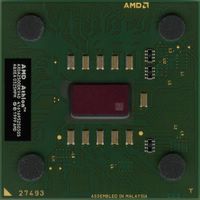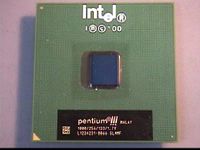March 30, 2005
March 28, 2005
Intel Celeron 300 'A'
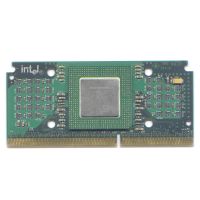
After having their wrists slapped by customers who bought the poor Level 2 cache-less 266 and 300MHz versions (Covington Core) of the Celeron (or Celery as it became known), the new A-Variant (Mendocino Core) Celeron finally got 128k L2 cache which increased its performance exponentially. For the first time, the L2 cache was placed onto the CPU die instead of having it external on the mainboard or soldered onto the cpu module.
By running the L2 cache at full speed instead of only half-speed like the Pentium-II did, these chips were pretty fast and in some cases on par with its big and much more expensive brother (When was the last time anyone said that about a Celeron?). The 300MHz variant was especially suitable for overclocking, mostly by just altering the FSB speed from 66MHz to 100MHz which usually still gave a rock-stable system. This Celeron comes in a Slot-1 package and was produced in Autumn 1998.
The last 486

The last of the intel 486's circa 1994. This baby really gave me the edge in Quake when I first got her to replace an even older 486 dx50. The oddest thing about her is that she was the first 486 that I had ever seen with an integrated heatsink. She was even faster than the first generation of Pentiums - ha!
March 22, 2005
Not a Pentium 1, and yet not quite a Pentium 2
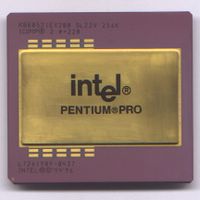
This Pentium Pro runs at 200MHz and has 256kB cache. In 1995, The Pentium Pro was the choice of the IT Manager that had large x86 servers as they were the first x86 chip to be able to address more than 4GB of RAM. This is the highest the clock speed went to, though the cache size was increased - first to 512kB then to an incredible 1024kB.
Even in the days of the Pentium 2, server manufacturers preferred the Pro as it had the larger cacheable range of 4GB whereas the first P2s were unable to cache RAM beyond 512MB. In addition to this limitation, the Pentium 2's (Klamath core) L2-cache ran at half clock speed. With the introduction of P2's 'Deschutes' core (333MHz and up) its reign was finally over as the new line of P2s finally offered a 4GB cacheable range, far higher clock speeds and higher bus speeds.
March 21, 2005
The AMD K5, a much underrated chip
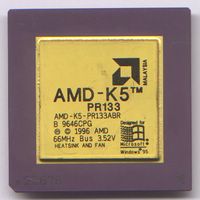
AMD have come a long way from this, and yet this was the beginning of innovation over emulation from the California based Processor manufacturer. This was their first fully self-developed x86 CPU and it is a truly a remarkable one.
While all previous AMD x86 CPUs used Intel microcode and therefore could be considered 'clones', this one was completely different. Instead of natively processing the code, the K5 did an interesting pre-translation to a RISC-like code, like NexGen chips did before and all current x86 chips I know of do today. This took AMD years to develop so that the first K5 chips joined the processor war late, compared to Cyrix and Intel counterparts.
When those K5 chips finally arrived in early 1996, both Cyrix and Intel already had their 200MHz/PR200 parts out, but with its 75MHz and 90MHz parts AMD was hopelessly out-paced. In addition, the early 'SSA5' versions were still running sub-optimally - you might want to call them a working 'pre-release' K5.
In May 1996, AMD switched to the K5 label instead of 5k86 (no-one would remember that, would they!). So this K5-PR133 is a chip running at 100MHz and was produced in late 1996 and performed (according to AMD) as fast as a Pentium 133MHz.
Like the Intel Pentium, the K5 was a superscalar design meaning that it had more than one execution unit per processor. This allowed it too to make the quantum leap in performance over the 486 which was common with 5th generation designs. It too was also pin compatible with the then prevailing Socket 5 and 7 motherboard connectors. This allowed it to run in the same motherboards as the Pentium itself.
The first Pentium!

This distinctive specimen is a gold topped Pentium running at a blistering 60MHz, which made the headlines soon after release due to the now infamous FDIV-bug.
In late summer of 1994 a mathematician from USA detected that the FPU of the Pentium core in some cases didn't divide as accurately as it should. Not only the P-66, but the P-75, P-90 and P-100 all had the same flaw. Unfortunately, Intel made some bad decisions at this point which severely harmed their reputation. After a phase of denial, Intel offered a replacement chip to any customer who could prove that they did scientific computing with the Pentium.
You could easily see if your Pentium was flawed by a simple division using the ordinary calculator program that came with Windows. Intel's reputation was at stake - you simply couldn't rely on a Pentium based computer producing the right results anymore.
Towards the end of 1994 they offered replacement chips for any flawed Pentium. Even today you can still get a replacement chip for your old Pentium (like this one).
Unfortunately, too many people returned their flawed CPUs which is very sad from a collector's perspective.
An interesting note is that Intel had already discovered this flaw before the matter became public while they were working on a FPU for the Pentium-Pro.
A deceased Pentium 2
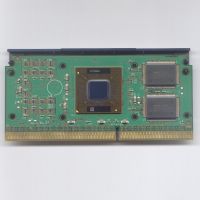
Another dead 'un, donated by a workmate. It's a Pentium 2 400MHz that died of natural causes. It's not as well constructed as the earlier P2's as the heatsink is supposed to fit straight on to the CPU core.
I actually liked SLOT 1 'cartridge' CPUs as they weren't as fiddly as those with pins, which could bend or in some cases break...
The first CPU I ever killed
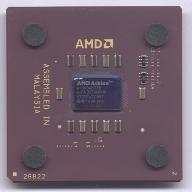
A 'Classic' Athlon Thunderbird @1GHz running on a 100MHz Front Side Bus. My first 1GHz part, it powered my main machine for a year. One fateful day I tried the pencil trick on the bridges and decided that placing the heatsink/fan on top of the processor would be enough to cool the core rather than locking it down.
Needless to say it's dead, though not forgotten.
March 20, 2005
The AMD K6-2
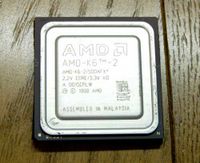
The 'Pentium 2 Killer', or at least that's what I was told when I bought her - the AMD K6-2 running @ 500MHz. Very hot. Not very fast, but did the job cheaply. Still running in an old Windows 98SE machine for playing X-Wing!
Athlon XP 1700+
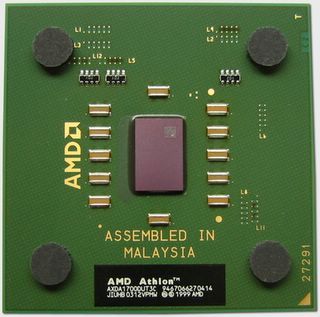
My latest addition. A factory 'multiplier unlocked' AMD Athlon XP 1700+. She has the renowned DUT3C core (which should allow it to be clocked above 2GHz instead of the stock 1467 MHz). As a Thoroughbred 'B' model, she was fabricated using the 0.13u process and has 256KB of Level 2 cache.
She currently sits in an ABIT KR7-A Raid which will only allow me to push her to 1700Mhz. One day...one day..
Motherboard musings and a collection exposed
I have always thought these blogs were a good idea, it simply never occured to me that I would have a use for one.
I have many computer related hobbies but creating websites isn't one of them - this blog system seems the perfect vehicle for my CPU and GPU Museum.
Ah, Processor collecting, as geeky and downright nerdy as I'm ever likely to get. Like a veritable Train-spotter, upon seeing a specimen I haven't encountered before I get goosebumps and feel flushed to the face!
Over the coming weeks, I hope to upload photos of those Central Processing Units and Graphics Processor Units that have indeed made me hot under the collar!
I have many computer related hobbies but creating websites isn't one of them - this blog system seems the perfect vehicle for my CPU and GPU Museum.
Ah, Processor collecting, as geeky and downright nerdy as I'm ever likely to get. Like a veritable Train-spotter, upon seeing a specimen I haven't encountered before I get goosebumps and feel flushed to the face!
Over the coming weeks, I hope to upload photos of those Central Processing Units and Graphics Processor Units that have indeed made me hot under the collar!

